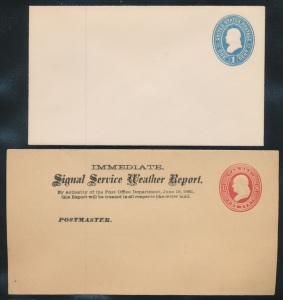Little realized by philatelists now is the fact that postal stationery was intended, by the originators of postage stamps and the early postal agencies, to rival stamps in use. Post Offfices around the world liked postal stationery because the sizes of the envelopes issued were uniform and thus facilitated handling. Most countries so wanted to encourage use of postal stationery in the nineteenth century that there was no surcharge for the envelope plus the stamp. This represented a considerable savings to postal users as envelopes were costly and stationery provide a complete mailing package for the price of a stamp.
Postal Stationery of the United States is listed in the Scott specialized catalog. Stamp collectors have long had the option of collecting US postal stationary either as complete envelopes or as just the embossed and printed design cut from the envelope-called a cut square. Postal Stationery is one of those areas where national preference have won out in philately. European collectors never collect cut squares. A German postal stationery envelope design that has been cut from the envelope is considered damages and is discarded. In US philately, there is a Scott album space for such an item.
Postal stationery collecting used to be much more popular both in the United States and around the world than it is today. In the last fifty years, postal stationery has declined in collector interest precipitously, and is continuing to do so today. This is for two reasons. First, and probably foremost, the decline in US postal stationery collecting has mirrored the decline in postal stationery collecting world wide. Envelopes are hard to store. They are bulky and for the most part far less attractive than stamps. Further, most collectors only have a given amount of time and money for their hobby. In the early days of the hobby, new issues were unusual (The United States issued nine stamps in 1953 for a total face value of 27c). Most collectors’ philatelic interest was not sated with this poor fare and collectors gravitated to other philatelic areas such as First day Covers, postal stationery and earlier US postage stamps to fill their collecting desires. As the USPS has become so very prolific in stamp issuing, FDSs, postal stationery and even earlier US collecting has lost out.
Further complicating the collecting of US postal stationery is how difficult specialists have made it. The are many varieties of the embossing in nineteenth and early twentieth century items, many of which have been given full catalog status by Scott. And the highly specialized Thorpe- Bartels catalog takes the specialization of US stationery to dizzying levels, listing sizes of the envelopes, watermarks of the envelope paper and even how the paper is cut and folded to form envelopes (called knives). There is a good rule in philately, especially in our modern period. The more esoteric and arcane a specialty becomes the more unlikely it is to attract new collectors.


